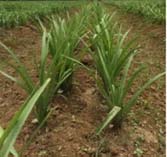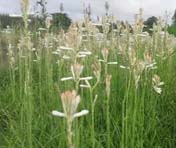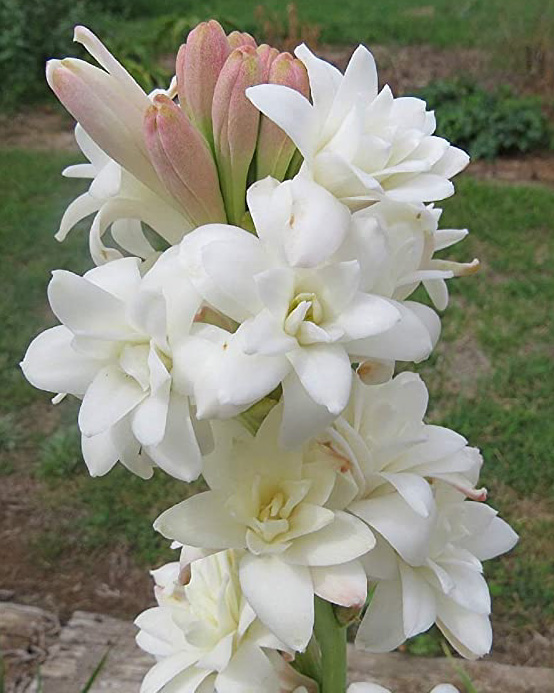cultivation practices
-
climate
Tuberose require moderate climate with temperature ranging from 20-30oC. It is a day neutral plant and good sunlight is essential for flowering. Very low temperature and frost damage the plants and flowers, and grows well in sunny situation. Tuberose is sensitive to water logging and hence proper drainage is essential. Water logging even for a short period damages the root system and affects growth and flowering.
-
propagation
Tuberose is multiplied through bulbs. Healthy bulbs with a diameter of 2 cm and above can be selected for planting. After flowering, leaves wither and the bulb enters a period of dormancy. At this stage, irrigation should be stopped and the bulbs are ready for harvest. The bulbs should be dug from the ground and dried under shade. Then, they should be separated from the clump and graded according to their size as small, medium and large bulbs. They have a dormancy period of about 4-6 weeks, during which they should not be planted.
-
soil

Tuberose is suited to a wide range of soils from loamy to sandy loam having a pH in the range of 6.5 to 7.5 with good aeration and drainage. The soils should be rich in organic matter and retain sufficient moisture for proper growth. Potting media consist of AFC + Soil + Sand + FYM (1:1:1:1) found to be suitable.
-
Planting
The field should be prepared well to get a fine tilth and well decomposed farm yard manure at the rate of 20 tonnes/ha should be applied along with 200 kg of neem cake enriched with 1 kg of Trichoderma harzianum. The healthy disease free bulbs (25 to 30 g) with a diameter of 2 cm and above are suitable for planting and the time of planting varies in different parts of India. In general, tuberose bulbs (63,000 bulbs per ha) are planted on raised beds with a spacing of 30 x 30 cm at 2.5 cm depth during April - September. Before planting they should be dipped in a mixture of 2 g/litre of carbendazim & 2 ml/litre chloropyriphos for 15-20 minutes to prevent incidence of fungal diseases and mealy bugs.
-
IrRigation

Irrigate the field before planting for better sprouting. Irrigation may be avoided until the bulbs sprout. Excess moisture in the soil at the time of sprouting results in the rotting of bulbs. Micro-irrigation may be adopted to economise the water use and increase the water and nutrient use efficiency. Depending on the weather condition, 4 to 6 litres of water per square metre can be given daily through drip irrigation.
-
Nutrient requirement
Basal fertilizer application of well decomposed farm yard manure at the rate of 25 ton with 130kg urea, 85kg diamonium phosphate & 100kg muriate of potash per hectare has to be applied at the time of field preparation. This has to be followed by fertigation as follows:
Up to 3 months after planting: 145kg urea, 52 kg MKP (0:54:32) and SOP (0:0:50) 60 kg/ha
4 to 9 months: 145 kg urea, 83 kg MKP (0:54:32) and SOP (0:0:50) 94 kg/ha
10 to12 months: 98 kg urea, 38 kg MKP (0:54:32) and SOP (0:0:50) 46 kg/ha
For ratoon crop, the basal application of FYM and fertilizer to be repeated at the beginning of the cropping season. Need based foliar spray of ZnSO4 @ 0.5% + FeSO4@ 0.2%+Boric acid @0.1% to be practiced for getting better growth and yield in tuberose. -
Harvesting & yield
For cut flower purpose, the tuberose spikes is harvested when the first pair of flower buds opens on the spike. For loose flowers, fully matured flower buds which are at the horizontal position on flowers stalk is harvested during morning hours. Tuberose bulbs are harvested when the flowering is completed. Now the old leaves become dry and bulbs are almost dormant. Irrigation is withheld and soil is allowed to dry before digging out the bulbs. After digging, the bulbs are lifted out; the bulblets are separated and used as seed stock for the next season. The bulbs are placed on shelves to dry. The bulbs is stored and their position is changed every few days for uniform drying, to prevent rotting and fungal diseases.

